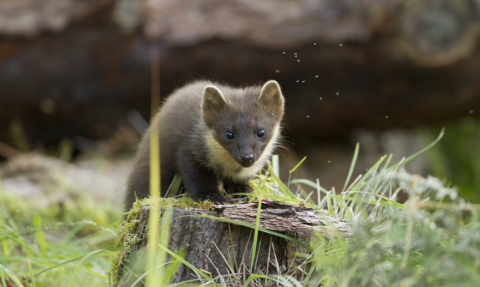
Mark Hamblin/2020VISION
Get to know pine martens
What are pine martens?
Pine martens are members of the weasel family (mustelids). They are arboreal (tree-dwelling) and live at very low densities across large areas. They have rich brown fur with a cream throat and chest and are similar in size to a small domestic cat.
What do pine martens eat?
Pine Martens eat what is seasonally and locally abundant. Their diet varies with location and season but comprises mostly small mammals such as field and bank voles. They also feed on birds and their eggs, invertebrates such as beetles and wasps, large quantities of berries in the autumn. Pine martens scavenge carrion too, particularly in the winter. They are known to eat squirrels, although this only makes up a very small proportion of their diet.
What habitats do pine martens require?
The pine marten is a woodland specialist and has excellent climbing skills well suited to wooded habitats. They rest and breed in holes in trees, large bird nests, squirrel dreys, fallen trees, thick vegetation, and sometimes man-made structures. They also benefit from species-rich open habitats, for example grassland, alongside woodlands where they can hunt and forage. Pine martens are solitary and can have fairly large territories.
What size territories do pine martens need?
Pine marten territory or home range sizes vary depending on the quality of habitat and food availability but are typically in the region of 5km2 to 10km2. Dispersal distances can vary between 0 to 50km. In other reintroduced populations, some individuals have dispersed over 100km from the release point, but this is a rare exception.
When and why did pine martens die out in South West England?
Humans are responsible for the decline of pine martens across the UK. Pine martens were one of the most common carnivores in prehistoric times and remained widespread, albeit rare, in the UK's woodlands until about 150 years ago.
Clearance of woodlands over thousands of years removed much of the pine marten's habitat. Pine marten fur was highly valued in medieval times making them a target for trapping. Tudor laws which lasted until the 19th century demanded many wild animals were killed by parishes, including pine martens. The rise of sporting estates in the 18th and 19th centuries brought the now rare pine marten to the verge of extinction in the UK. The pine marten is thought to have become extinct in Devon, Somerset, and Cornwall between 1870-1880. There has been no evidence of a pine marten population in the South West since the late 19th century.
Have there been any sightings of pine marten in Devon and Somerset since they became extinct?
Yes. There have been occasional sightings of pine martens in Devon and Somerset. Confirmed sightings in recent decades are most likely to result from animals that have escaped from private collections or have been released unofficially. It is unlikely that this type of release would result in a sustainable population of pine martens. The animals are likely to travel large distances in search of other pine martens, leaving them at high risk of mortality, usually through road traffic accident.
Our plan, through the Two Moors Pine Marten Project, is to manage pine marten reintroduction in a controlled manner to avoid or mitigate such risks. This will include working closely with key stakeholders, carefully assessing the release sites for suitability, carrying out health checks on the animals, and obtaining the necessary licences.
Are pine martens protected?
Yes. Pine martens are listed under Schedule 5 of the Wildlife and Countryside Act (1981). It is therefore illegal to intentionally trap, injure or kill pine martens or disturb their dens. Any research that could disturb pine martens, which includes trapping and monitoring den boxes, must be done under a licence from the relevant statutory body (NatureScot, Natural Resources Wales, or Natural England).
Want to know more?
See our full list of frequently asked questions here
